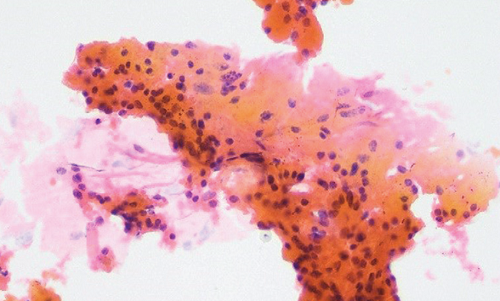Application of the Milan System of Reporting Salivary Gland Cytopathology: A Retrospective Cytohistological Study in a Tertiary Medical Center
DOI:
https://doi.org/10.21141/PJP.2022.03Keywords:
cytopathology, fine needle aspiration biopsy, Milan System, salivary glandAbstract
Background. A fine needle aspiration biopsy has been established as a safe, minimally invasive procedure in evaluation of salivary gland lesions. The complex overlapping cytomorphology of these lesions are challenging for pathologists, hence the introduction of an evidence-based system, the Milan System of Reporting Salivary Gland Cytopathology, to improve overall patient care. The study was taken up to reclassify salivary gland lesions from previous FNA biopsies in order to determine sensitivity, specificity, positive and negative predictive values of FNA, and evaluate the risk of malignancy of the various categories of the Milan system.
Methodology. This was a 6-year retrospective descriptive study in a tertiary medical center. All salivary gland FNA cases were reviewed by two pathologists, and re-classified into the six categories of the Milan System. The number of false positive, false negative, true positive and true negative cases were obtained by comparing
with the final histopathology diagnosis, and the risk of malignancy per category were calculated.
Results. A total of 76 cases were reviewed and the overall average of the two readers diagnostic accuracy were 85.02% (95% CI: 84.50-85.60%), sensitivity and specificity were 80.77% (95% CI: 79.90-81.60%) and 86.19% (95% CI: 85.70-86.70%), respectively; positive and negative predictive values were 62.16% (95% CI: 60.70-63.60%) and 94.17% (95% CI: 94.00-94.40%), respectively.
Conclusion. The Milan System category with highest risk of malignancy was Malignant (Category VI – 100%). FNAB is still a reliable tool for clinicians, and use of the Milan System of Reporting Salivary Gland Cytopathology is beneficial in increasing efficacy of communication among clinicians to improve patient care.
Downloads
References
2. Reinheimer A, Vieira DSC, Cordeiro MMR, Rivero ERC. Retrospective study of 124 cases of salivary gland tumors and literature review. J Clin Exp Dent. 2019;11(11):e1025-32. PMID: 31700577. PMCID: PMC6825733. https://doi.org/10.4317/jced.55685.
3. van Zante A, Ha P, Pusztaszeri MP. The Milan System for reporting salivary gland cytopathology. AJSP Review and Reports. 2020;25(5):235-42. https://doi.org/ 10.1097/PCR.0000000000000405.
4. Cibas ES, Ducatman BS. Cytology: Diagnostic Principles and Clinical Correlates, 3rd ed. Elsevier Saunders; 2016.
5. Chen YA, Wu CY, Yang CS. Application of the Milan System for reporting salivary gland cytopathology: a retrospective study in a tertiary institute. Diagn Cytopathol. 2019;47(11):1160-7. PMID: 31313521. https://doi.org/10.1002/dc.24279.
6. Farahani SJ, Baloch Z. Retrospective assessment of the effectiveness of the Milan system for reporting salivary gland cytology: a systematic review and meta-analysis of published literature. Diagn Cytopathol. 2019;47(2):67-87. PMID: 30375201. https://doi.org/10.1002/dc.24097.
7. Santiago KJB, Roldan RA, Castañeda SS. Accuracy of Fine Needle Aspiration Biopsy in Diagnosing Parotid Gland Malignancy. Philipp J Otolaryngol Neck Surg. 2016;31(2):24-6. https://doi.org/10.32412/pjohns.v31i2.229.
8. Amita K, Rakshitha HB, Singh A, Vijay Shankar S. Evaluation of accuracy of milan system for reporting salivary gland cytology: review of morphology and diagnostic challenges in each category. J Cytol. 2020;37(1):18-25. PMID: 31942093. PMCID: PMC6947732. https://doi.org/10.4103/JOC.JOC_191_18.
9. Viswanathan K, Sung S, Scognamiglio T, Yang GCH, Siddiqui MT, Rao RA. The role of the Milan System for reporting salivary gland cytopathology: a 5-year institutional experience. Cancer Cytopathol. 2018;126(8):541-51. PMID: 29797690. https://doi.org/10.1002/cncy.22016.
10. Wangsiricharoen S, Lekawanvijit S, Rangdaeng S. Agreement between rapid on-site evaluation and the final cytological diagnosis of salivary gland specimens. Cytopathology. 2017;28(4):321-8. PMID: 28419576. https://doi.org/10.1111/cyt.12428.
11. Kakkar A, Kumar M, Subramanian P, et al. Utility of the Milan system for reporting salivary gland cytopathology during rapid on-site evaluation (ROSE) of salivary gland aspirates. Cytopathology. 2021;32(6):779-88. PMID: 34273214. https://doi.org/10.1111/cyt.13038.
12. Wangsiricharoen S, Maleki Z. Risk stratification and clinical outcome in the atypia of undetermined significance category in the Milan System for reporting salivary gland Cytopathology. Cancer Cytopathol. 2021;129(2):132-9. PMID: 32936993. https://doi.org/10.1002/cncy.22352.
13. Kala C, Kala S, Khan L. Milan system for reporting salivary gland cytopathology: an experience with the implication for risk of malignancy. J Cytol. 2019;36(3):160-4. PMID: 31359916. PMCID: PMC6592120. https://doi.org/10.4103/JOC.JOC_165_18.









